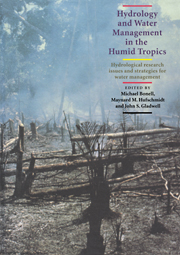 Hydrology and Water Management in the Humid Tropics
Hydrology and Water Management in the Humid Tropics Published online by Cambridge University Press: 23 December 2009
ABSTRACT
Although the absolute variability of weather features in the tropics is less than that at higher latitudes, tropical weather and climate are rich in variation on time scales from the diurnal to decadal. Moreover, the climate of the tropics is closely linked to the behaviour of the upper oceans, which provide inertia to the climate system and which act as a moisture source for convective heating of the atmosphere. Latent heating from convection is a common factor in all aspects of variability in the tropical climate. The links between the major causes of variability are reviewed in the present work.
INTRODUCTION
Weather at the mid-latitudes is clearly associated with baroclinic fronts and other synoptic features that are controlled by the earth's rotation. It is, therefore, natural to assume that the tropics, where these Coriolis effects are small, should have weather with a distinctive lack of structure. Charney & Shukla (1981) quantify this effect by showing that the temperature variance increases away from the equator. This apparent lack of structure is supported by the observation that persistence is a useful weather forecast in the tropics. Indeed, operational short-range weather forecasting is generally no more accurate than persistence (Holland et al., 1987). But this result suggests that the basically quiescent weather is punctuated by intermittent and unpredictable events. In this paper, these events, their interconnections and progress on improving our understanding of them are reviewed.
One manifestation of the apparent lack of features in tropical weather is the observation that the temperature generally does not vary greatly, even following the passage of a weather system.
To save this book to your Kindle, first ensure [email protected] is added to your Approved Personal Document E-mail List under your Personal Document Settings on the Manage Your Content and Devices page of your Amazon account. Then enter the ‘name’ part of your Kindle email address below. Find out more about saving to your Kindle.
Note you can select to save to either the @free.kindle.com or @kindle.com variations. ‘@free.kindle.com’ emails are free but can only be saved to your device when it is connected to wi-fi. ‘@kindle.com’ emails can be delivered even when you are not connected to wi-fi, but note that service fees apply.
Find out more about the Kindle Personal Document Service.
To save content items to your account, please confirm that you agree to abide by our usage policies. If this is the first time you use this feature, you will be asked to authorise Cambridge Core to connect with your account. Find out more about saving content to Dropbox.
To save content items to your account, please confirm that you agree to abide by our usage policies. If this is the first time you use this feature, you will be asked to authorise Cambridge Core to connect with your account. Find out more about saving content to Google Drive.